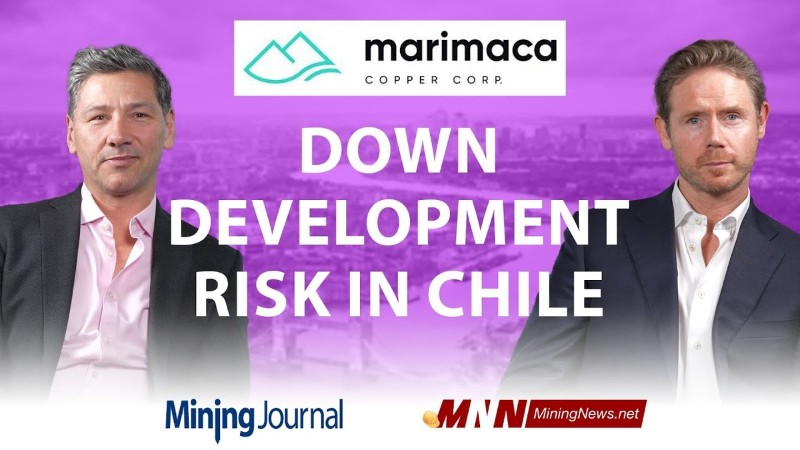Marimaca Faces Development Risk In Mines In Chile
Published on 14 Jun 2024

In a recent interview with Mining Journal’s Chris Cann, Marimaca's Chief Executive Hayden Locke illuminates how the company is addressing the development risks associated with its flagship project in Chile. Locke’s discussion covers various topics, including infrastructure advantages, political climate, and community engagement, providing a comprehensive view of Marimaca’s strategic approach to mitigate potential investor concerns.
The Chilean Context
Chile is recognized as a prime location for mining investments, consistently ranking highly in global investment risk indexes. Locke praises Chile's advanced education system, the long history of mining, and the populace's understanding of mining's importance to the national economy. Despite recent political unrest and the drafting of a new constitution, Locke remains optimistic about Chile's stability and its position as a top investment jurisdiction in Latin America.
Political Climate and Its Impact
Locke discusses the implications of the political environment in Chile, particularly with the upcoming elections. President Gabriel Boric's platform of change and reform initially caused industry concern due to rhetoric around increased taxes and nationalization. However, Locke notes that while the desire for a greater share of mineral wealth persists, the practical realities of mining's importance have moderated political stances. The potential for a shift in political power introduces some uncertainty, but Locke remains confident in Chile’s enduring attractiveness for mining investments.
Community Engagement and Social License
A key component of Marimaca’s strategy is its proactive approach to community engagement. Since 2016, the company has maintained a consistent presence in the local community of Mejillones, where the project is based. Locke emphasizes the importance of transparency and open communication with local stakeholders, aiming to ensure that the benefits of the mining project are widely shared. This includes providing employment, supporting local services, and improving overall quality of life.
Marimaca’s efforts go beyond mere compliance with legal requirements. The company is committed to best practices in stakeholder engagement, holding regular consultations and addressing community concerns. This proactive stance is designed to secure the necessary social license, critical for the project's long-term success.
Navigating Permitting and Regulatory Challenges
Permitting is a significant hurdle for mining projects worldwide, and Chile is no exception. However, Locke highlights Chile’s permitting process's transparency as a major advantage. All communications between the company and the government during the permitting process are publicly accessible, allowing for clear and open dialogue. This transparency reduces the risk of corruption and provides a predictable framework for project approval.
Locke acknowledges the inherent risks of permitting delays and emphasizes Marimaca’s thorough preparation to mitigate these risks. The company has invested significant time and resources into understanding and addressing environmental and social impacts, ensuring that their project meets all regulatory requirements.
Infrastructure and Capital Cost Management
One of Marimaca’s key advantages is its proximity to existing infrastructure. The project is located near major ports, power generation facilities, and supply chains, significantly reducing the need for new infrastructure investments. This strategic location lowers capital costs and minimizes potential logistical challenges.
Locke explains that Marimaca’s project, which involves an SX-EW (solvent extraction-electrowinning) process, benefits from lower capital intensity than traditional mining operations. The project’s design eliminates the need for milling, further reducing costs. Additionally, the lack of significant pre-stripping requirements—a common cost driver in open-pit mining—adds to the project’s economic feasibility.
Addressing Labor and Construction Risks
Labor productivity and civil works are major areas of concern for capital cost blowouts. Locke stresses the importance of realistic planning and accurate estimation of labor hours required for construction. Marimaca aims to mitigate these risks by partnering with experienced contractors like Ausenco, which has a track record of building similar projects.
The company’s emphasis on preparation extends to its internal analysis and conservative assumptions regarding capital costs. This cautious approach is designed to ensure that the project remains financially viable despite unforeseen challenges.
Conclusion
In this insightful interview, Hayden Locke provides a detailed overview of Marimaca’s strategies to navigate the complexities of developing a mining project in Chile. From leveraging existing infrastructure to engaging with local communities and ensuring regulatory compliance, Marimaca is taking comprehensive steps to mitigate development risks.
Watching the full interview with Hayden Locke offers valuable insights for those interested in a deeper dive into Marimaca’s approach and the broader context of mining in Chile. Locke’s discussion with Chris Cann provides a nuanced understanding of the challenges and opportunities mining companies face in this dynamic region.
You May Also Like: Green Mining Revolution: Marimaca Copper Leads the Way
